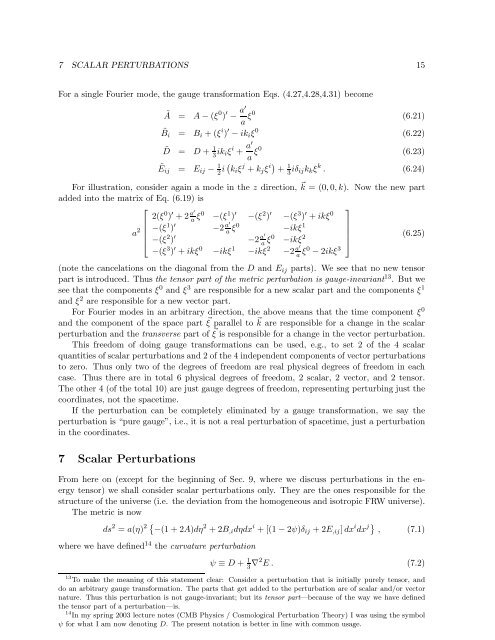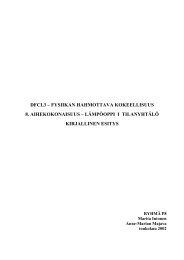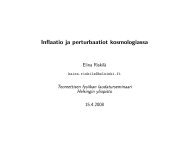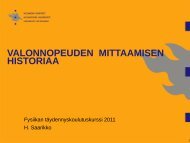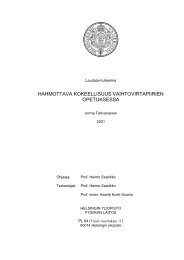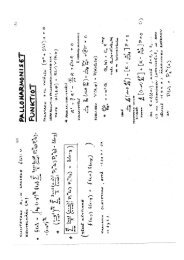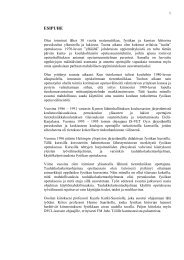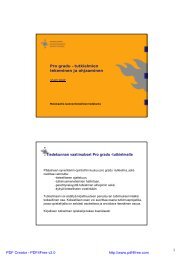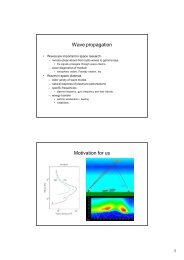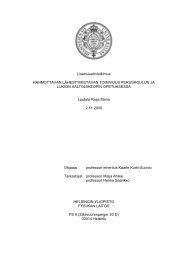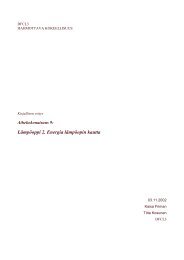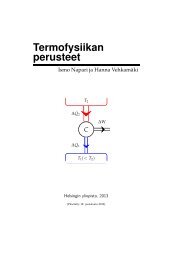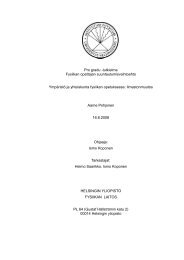Cosmological Perturbation Theory, 26.4.2011 version
Cosmological Perturbation Theory, 26.4.2011 version
Cosmological Perturbation Theory, 26.4.2011 version
You also want an ePaper? Increase the reach of your titles
YUMPU automatically turns print PDFs into web optimized ePapers that Google loves.
7 SCALAR PERTURBATIONS 15For a single Fourier mode, the gauge transformation Eqs. (4.27,4.28,4.31) becomeà = A − (ξ 0 ) ′ − a′a ξ0 (6.21)˜B i = B i + (ξ i ) ′ − ik i ξ 0 (6.22)˜D = D + 1 3 ik iξ i + a′a ξ0 (6.23)Ẽ ij = E ij − 1 2 i( k i ξ j + k j ξ i) + 1 3 iδ ijk k ξ k . (6.24)For illustration, consider again a mode in the z direction, ⃗ k = (0,0,k). Now the new partadded into the matrix of Eq. (6.19) is⎡⎤2(ξ 0 ) ′ + 2 a′a ξ0 −(ξ 1 ) ′ −(ξ 2 ) ′ −(ξ 3 ) ′ + ikξ 0a 2 −(ξ 1 ) ′ −2 a′⎢a ξ0 −ikξ 1⎣ −(ξ 2 ) ′ −2 a′a ξ0 −ikξ 2 ⎥ (6.25)⎦−(ξ 3 ) ′ + ikξ 0 −ikξ 1 −ikξ 2 −2 a′a ξ0 − 2ikξ 3(note the cancelations on the diagonal from the D and E ij parts). We see that no new tensorpart is introduced. Thus the tensor part of the metric perturbation is gauge-invariant 13 . But wesee that the components ξ 0 and ξ 3 are responsible for a new scalar part and the components ξ 1and ξ 2 are responsible for a new vector part.For Fourier modes in an arbitrary direction, the above means that the time component ξ 0and the component of the space part ⃗ ξ parallel to ⃗ k are responsible for a change in the scalarperturbation and the transverse part of ⃗ ξ is responsible for a change in the vector perturbation.This freedom of doing gauge transformations can be used, e.g., to set 2 of the 4 scalarquantities of scalar perturbations and 2 of the 4 independent components of vector perturbationsto zero. Thus only two of the degrees of freedom are real physical degrees of freedom in eachcase. Thus there are in total 6 physical degrees of freedom, 2 scalar, 2 vector, and 2 tensor.The other 4 (of the total 10) are just gauge degrees of freedom, representing perturbing just thecoordinates, not the spacetime.If the perturbation can be completely eliminated by a gauge transformation, we say theperturbation is “pure gauge”, i.e., it is not a real perturbation of spacetime, just a perturbationin the coordinates.7 Scalar <strong>Perturbation</strong>sFrom here on (except for the beginning of Sec. 9, where we discuss perturbations in the energytensor) we shall consider scalar perturbations only. They are the ones responsible for thestructure of the universe (i.e. the deviation from the homogeneous and isotropic FRW universe).The metric is nowds 2 = a(η) 2 { −(1 + 2A)dη 2 + 2B ,i dηdx i + [(1 − 2ψ)δ ij + 2E ,ij ] dx i dx j} , (7.1)where we have defined 14 the curvature perturbationψ ≡ D + 1 3 ∇2 E . (7.2)13 To make the meaning of this statement clear: Consider a perturbation that is initially purely tensor, anddo an arbitrary gauge transformation. The parts that get added to the perturbation are of scalar and/or vectornature. Thus this perturbation is not gauge-invariant; but its tensor part—because of the way we have definedthe tensor part of a perturbation—is.14 In my spring 2003 lecture notes (CMB Physics / <strong>Cosmological</strong> <strong>Perturbation</strong> <strong>Theory</strong>) I was using the symbolψ for what I am now denoting D. The present notation is better in line with common usage.


